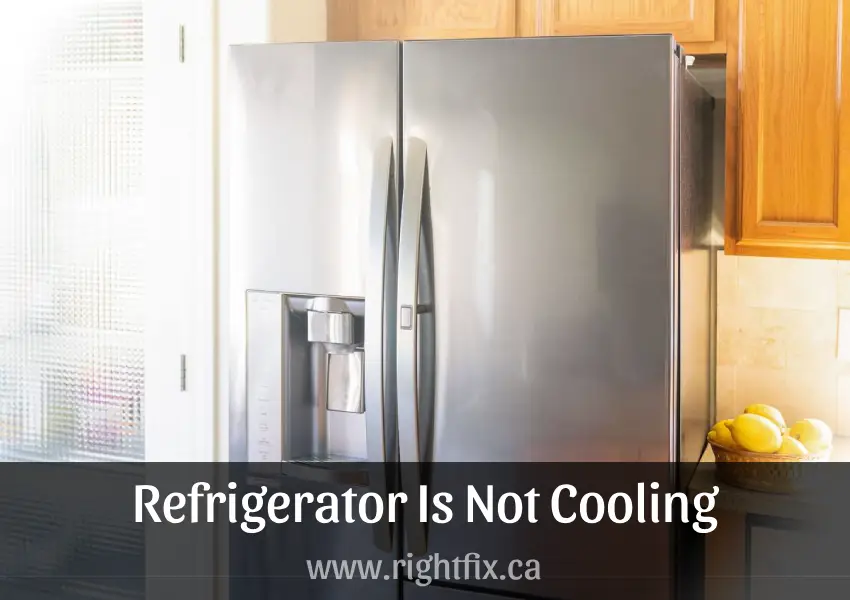Reasons Your Refrigerator Is Not Cooling
Ignorance of your refrigerator's non-cooling could create significant issues including food squander and expanded energy utilization. From basic faults like wrong settings to more complicated ones needing professional repair, several elements might cause a refrigerator to not chill adequately. This article gives feasible answers for investigate and determine the non-cooling of your refrigerator. RightFix provides expert Fridge repair services to help restore your refrigerator to optimal performance.
Why Is My Refrigerator Not Cooling?
If your refrigerator be working anyway your ice chest isn't, there could be a couple of expected reasons. Realizing the reason will empower you to decide if master help is required or whether a DIY fix is practical. Issues with the indoor regulator, refrigerant, blower, or wind current framework are a few commonplace reasons a fridge won't chill.
How To Fix a Refrigerator Not Cooling
These instructions will help you troubleshoot and resolve a non-cooling refrigerator:
1. Make Sure It’s Plugged In
Making ensuring your refrigerator is correctly plugged in comes first and easiest. Even if it would seem to be functioning, a loose connection can cause a refrigerator to not chill.
2. Check Your Refrigerator Location
Your refrigerator could find it hard to chill appropriately in the event that it is kept too close to a wall or in a warmed environmental elements. Ensure adequate room around the fridge to give fitting wind stream.
3. Repair a Refrigerant Leak
Inappropriate cooling might result from a refrigerant leak. The refrigerator won't chill as low a refrigerant level indicates. Since fixing a refrigerant leak calls for specific understanding, it is advised to call a qualified repair company.
4. Replace a Bad Refrigerator Compressor
The center of the chilling framework in your refrigerator is the compressor. If the compressor be broken, your fridge won't chill. The compressor is complicated and expensive to fix, hence this problem usually calls for professional repair or replacement.
5. Clean Clogged Condenser Coils
Your fridge's cooling viability might be hampered by messy or hindered condenser loops. These coils discharge refrigerator's internal heat. If they be unclean, the refrigerator might not chill as it should. One can avoid this by routinely cleaning the coils.
6. Change the Broken Condenser Fan
The fridge's loops' intensity is assisted with being dispersed by the condenser fan. If the fan fall flat, the fridge would overheat, thusly hindering cooling skill. Restoring correct cooling capacity requires a broken fan to be replaced.
7. Restore the Nonfunctioning Evaporator Fan
The refrigerator's evaporator fan moves cold air within. If it break down, the refrigerator won't chill as intended. This becomes especially troublesome if the freezer is still running. Test the fan motor and, should necessary, replace it.
8. Clear Blocked Air Damper
Cold air from the freezer to the refrigerator is flowed under control by the air damper. Blocked or faulty it can stop the refrigerator from chilling. Remove all obstacles and guarantee proper damper operation.
9. Properly Store Food
Overloading the refrigerator or storing hot food will restrict airflow and lower cooling effectiveness. Proper food organization helps to prevent congestion and enable best ventilation within the refrigerator.
10. Replace Old Gaskets
Door gaskets worn or torn can permit warm air into the refrigerator, which would cause it to struggle with cooling. Look at the gaskets and replace them should they be damaged or no longer tightly sealing.
11. Rewire Faulty Circuitry
Inaccurate wiring or electrical components could cause a refrigerator to not chill. See an appliance repair specialist to rewire any malfunctioning refrigerator components if you believe the electrical system is broken.
Troubleshooting Tips
Why Is My Refrigerator Not Cooling, But My Freezer Is?
Typically, the issue is wind stream on the off chance that your refrigerator is working yet your fridge isn't. A messed up evaporator fan or an impeded air vent is the most frequently happening cause. The refrigerator relies upon wind stream to stay cold; the refrigerator’s cooling framework works freely.
What Would Cause a Refrigerator To Stop Getting Cold?
Issues with the indoor regulator, blower, condenser loops, or refrigerant hole could be among the different why your fridge could stop being cold. Incessant support including condenser curl cleaning maintains a strategic distance from these issues.
How Do You Fix a Refrigerator That Is Not Cooling?
Begin by taking a gander at the power supply, cleaning the condenser loops, and ensuring the evaporator fan is working to fix a fridge that isn't cooling. If those fixes fall flat, you might need to supplant more convoluted parts like the blower or refrigerant.
Should I Unplug a Refrigerator That’s Not Cooling?
Yes, unplugging your refrigerator will help the system to be reset if it is not cooling. A few minutes later, plug it back in and see whether it starts to chill. Additional troubleshooting could be required should the issue continue.
Following these troubleshooting techniques will enable you to locate and resolve a non-cooling refrigerator problem. Professional assistance may occasionally be needed, particularly if the issue includes complicated parts like the compressor or refrigerant system. RightFix provides expert repair services to help restore your refrigerator to optimal performance.
This blog provides doable fixes for a refrigerator not chilling, including compressor or fan replacement and refrigerant leak repair. These pointers will help your refrigerator last longer and keep its cooling effectiveness.
Location we Service
- Ajax
- Alliston
- Aurora
- Bolton
- Bradford
- Brampton
- Brantford
- Burlington
- Caledon
- Cambridge
- Concord
- East York
- Etobicoke
- Georgetown
- GTA
- Guelph
- Halton Hills
- Hamilton
- Innisfil
- Keswick
- King City
- Kitchener
- Kleinburg
- Maple
- Markham
- Milton
- Mississauga
- New Tecumseth
- Newmarket
- North York
- Oakville
- Orangeville
- Oshawa
- Pickering
- Richmond Hill
- Scarborough
- Schomberg
- Stouffville
- Thornhill
- Toronto
- Unionville
- Uxbridge
- Vaughan
- Waterloo
- Whitby
- Woodbridge





























